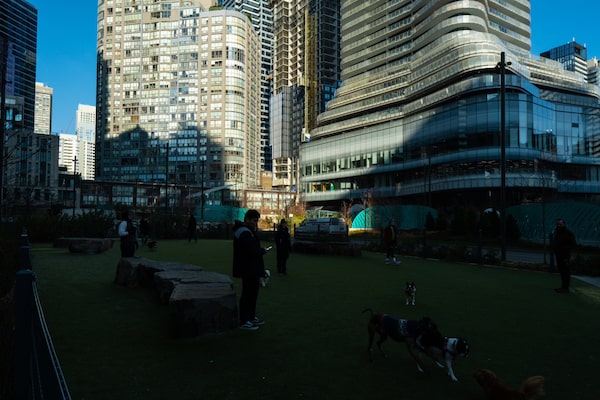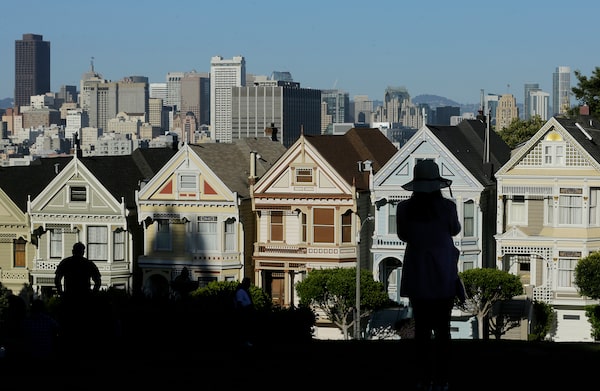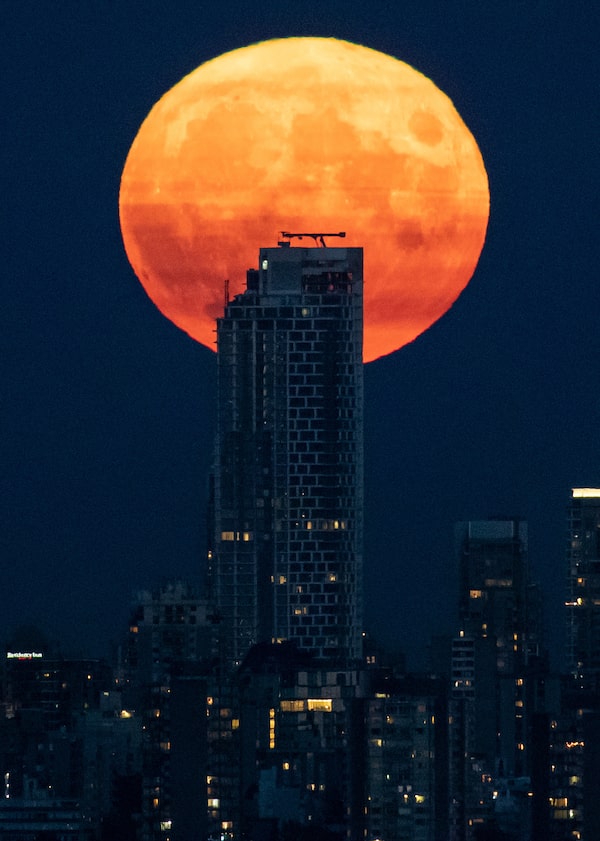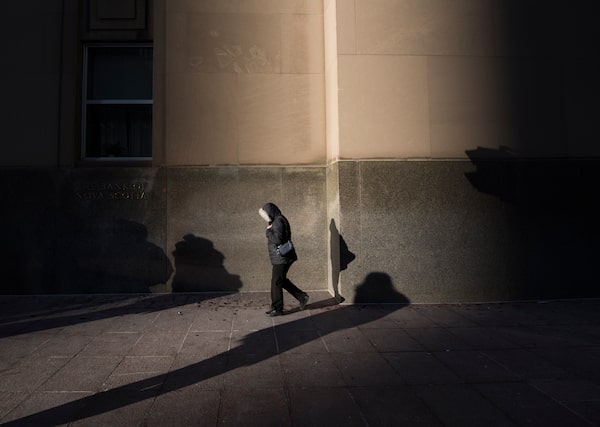The new buildings were just what Toronto needed. More than 800 new rental apartments, about a third of them permanently affordable. These new homes would rise on the site of an old provincial building. The problem: They were too tall. One tower would rise 50 storeys into the air, and so it would cast shadow on a park half a block away – covering about a quarter of its surface – for up to three hours a day.
This, according to local planning policy, was unacceptable. While Opera Place Park is half a block away from these new towers, city planning policy insists on “no net new shadow” on that park. So the complex of more than 800 units would have to get smaller.
Such discussions are not unusual in Canadian urban planning. While this past summer was the hottest on record, Toronto’s government – along with those of other Canadian cities – often argues that sunlight on public places is a crucial civic asset.
This paradox is at the heart of urban design, the field that manages the design of neighbourhoods. Heat is a growing threat to public health, yet regulations often push in the opposite direction: New buildings are often required to avoid casting shadow.
Whether that makes sense in light of the warming climate is another question entirely.

Darkness falls on Dr. Lillian McGregor Park, just north of Opera Place Park, on Wellesley Street between Bay and Yonge. The architects of the condo tower next door had to conduct a shadow study to see the effect on surrounding areas at different times of day.Adetona Omokanye/The Globe and Mail
In the contemporary field of urban design, shade has emerged as a prime concern. While policies vary between cities, most or all of Canada’s big cities regulate the shape of buildings to control when and where they cast shadows.
Shadows are “among the most quantifiable” variables in the field of urban design, says the planner and urban designer Brent Toderian, and civic officials treat them with great emphasis.
“I understand the value of providing sunlight access onto streets in cold-weather cities. That has a value in urban design,” says Mr. Toderian, a prominent urban-planning consultant who has served as chief planner for Calgary and Vancouver. “But when did we decide that that value was more important than any other in city making?”
That question is increasingly urgent as Canadians feel the effects of a huge housing shortage and climate change. Shade-related rules often mean that new buildings must be smaller, shorter and farther apart from each other; this reduces the amount of housing that can be built on a site and makes it more expensive.
At the same time, efforts to defend sunlight can seem at odds with a rising public-health threat from heat. Extreme heat events, such as the 2021 “heat dome” that killed almost 600 people in B.C., are increasingly common. In light of these changes, advocates such as Mr. Toderian suggest the consensus on shade needs to shift.
The idea of keeping streets sunny has a long history. In 1573, the Laws of the Indies, a set of rules for the Spanish colonization of the New World, prescribed various rules for new towns. Among them: “In cold places the streets should be wide and in hot places narrow.”
This direction from King Phillip II shaped colonial plans in Latin America, which were also oriented to take advantage of cool breezes. It follows a familiar logic in European cities: that a narrow street is a shadowy street, and a cool one, not suitable for cool climates.
Then in the 19th century, Western cities experienced massive growth and – in a few places – constructed tall buildings. Workers crowded into urban areas, often living in poor conditions. The emerging field of city planning evolved a series of ideas about light and air as integral to public health.
The idea of sunlight on the street was codified by New York’s Zoning Resolution of 1916, which insisted on buildings stepping back from the street to allow sun to reach the public realm. In Britain, the Rights of Light Act of 1959 established similar rules, building on a centuries-old tradition in common law. In each case, complex rules were and are used to model acceptable paths of sunlight. In dense, fast-growing New York, this generated a consistent building form: Beyond a certain height, towers “step back” progressively, like a wedding cake. Both the Empire State Building and the Chrysler Building reflect this logic.
However, the conditions that gave rise to these rules – the crowded skyscrapers of Manhattan’s business districts, and back-lane tenements of British industrial cities – never existed in many places in North America. And through the 20th century, new planning rules generally made dark and crowded conditions illegal.
As the planning profession grew rapidly in the mid-20th century, sunlight protection became a persistent idea – and acutely so in Canada.
Construction workers at the Toronto-Dominion Centre cheer in 1966 as they reach a milestone height on what was then the tallest building in the Commonwealth. Fireworks exploded over the city as they secured the last beam on the 56th floor.John McNeill/The Globe and Mail
The 1960s were a moment of turmoil in cities. The process of “urban renewal” had remade many North American metropolises with lots of new housing, modernized downtowns and car infrastructure.
Progressive politicians took control in Vancouver and Toronto with promises to push back on the excesses of urban renewal. A suspicion of towers and large-scale growth was widely shared among design professionals.
At the same time, the phrase “quality of life” was often deployed in urban planning. As many people chose the suburbs, cities felt they needed to compete by improving the experience for existing residents.
It was in this context that shade policy became entrenched. In 1974, a group of Toronto architects and planners led by George Baird wrote onbuildingdowntown, a set of design guidelines for downtown Toronto. That city’s core had just added a wave of skyscrapers surrounded by wide plazas. These buildings revived older concerns about uncomfortable “microclimates” of shade and wind – at a moment when governments had the inclination to push back against growth. The onbuildingdowntown report raised various points about qualitative changes to urban form, but one that persisted was a concern over shade and sunlight.
This issue was being discussed in other North American cities. In 1984, San Francisco passed a ballot measure known as the Sunlight Ordinance, which limits shadows from all buildings over 40 feet. If a building is going to cast a shadow on a city park and that shadow is “significant,” the city’s planning board can deny a building permit.
By 1990 one urban designer, the UC Berkeley planning professor Peter Bosselmann, had advised both San Francisco and Toronto on regulating sunlight in the cities. A Toronto study led by Prof. Bosselmann argued that streets “which are sheltered from unpleasant wind conditions [and] are sunny for much of the day provide amenity for the activities which … enrich urban life.”

People in San Francisco look toward historic Victorian homes, known as ‘Painted Ladies,’ and the skyline beyond. In the 1980s, San Francisco adopted measures that let planners deny building permits to projects that cast too much shade on city parks.Jeff Chiu/The Associated Press
Not every design professional agreed with this emphasis. James Brown, a veteran architect and urban designer with Toronto’s Brown + Storey, suggests the city’s approach overlooked qualitative aspects of public space to focus on these apparently scientific concerns. Planners “were focused on the buildings and on the shape of buildings, rather than on the space between the buildings – which is what matters,” Mr. Brown said in a recent interview.
However, shade regulation appeared in Toronto’s 1991 plan and has continued to be city policy. Across the city, new apartment buildings are often designed to step down diagonally toward their neighbours; an invisible 45-degree line, or “angular plane,” shapes the building’s form to avoid casting shadows on nearby houses. (This expectation has been firmly enforced in almost all cases for about a decade. Last month, federal Housing Minister Sean Fraser made a specific request for Toronto’s government to weaken these rules, and the city’s planning department has announced plans to do so.)
TOCore, Toronto’s 2019 plan for its downtown area, included “guidelines” that forbid “net new shadow” on sunny areas of parks. This policy is taken very seriously, and it shapes the dimensions and positions of new buildings. In 2020, when city staff were pushing back on a major office-building proposal in the downtown, a senior planning official argued that it would cast incremental shadows on a park – a park 400 metres away that is already shadowed by high-rise buildings, and to which the new tower would add a tiny sliver of “incremental” shadow.

A full moon rises behind a Vancouver condo tower under construction in 2021.Darryl Dyck/The Canadian Press
Other Canadian planning departments, including the City of Vancouver, also measure and regulate shade. While the details vary, Mr. Toderian, who is also founding president of the Council for Canadian Urbanism, suggests shade and sunlight appear to be “the most important” issue in many urban-design discussions, often driven by “a rather generalized and qualitative conversation about livability. And,” he adds, “that’s debatable, more so as we become a warming planet with warming cities.”
Indeed, many Canadian cities are getting warmer – significantly so. When city planners and urban designers were working on questions of comfort in the 1970s, they were on a climactically different planet than the one we now inhabit. The emphasis in these policies was, and is, generally on people remaining warm enough during the “shoulder seasons” of fall and winter.
The projections are sobering. “With climate change, the biggest impacts on Canadians who are living in urban environments are that the average temperature is going to rise and the number of uncomfortably hot days is going to rise,” says Alex Cannon, a research scientist at Environment and Climate Change Canada.
Dr. Cannon summarized the numbers for downtown Toronto, which was the subject of the Bosselmann study: There are twice as many uncomfortably hot summer days now as there were 30 years ago. “In the 1990s, we’d look at about a dozen days” with a humidex above 34. Today, that has doubled to around 24 days a year, Dr. Cannon says, and by the 2050s it will increase to 36 – a full month of uncomfortably hot weather.
From there, “it really depends on whether we hit our climate mitigation targets,” Dr. Cannon says. But a further increase in extremely hot days is entirely possible.
A cyclist cools off at a Vancouver misting station during 2022’s deadly heat wave in B.C.Jennifer Gauthier/Reuters
Toronto and also Vancouver are edging closer to a new situation in which the sun is not something to be welcomed but something to be managed with care.
And today in some warmer places, urban policy is already being shaped by a concern to provide adequate shade to protect people – especially vulnerable people – from too much sun. The idea of “shade equity” is a growing concern in public policy in California.
“Shade equity means having enough shade to ensure that people are protected from the sun so that they can safely live, work, learn and play,” explains V. Kelly Turner, an associate professor of urban planning and geography.
“Lack of shade has public-health effects that are not well understood, but we do know that cumulative exposure throughout the day … can make it difficult to concentrate, aggravate anger, exacerbate pre-existing conditions, and make it difficult to get core temperatures down to safe levels if [bodies] overheat.”
The key insight has been to increase the amount of shade in public spaces. Tree planting is frequently cited as a useful strategy, one that is difficult to implement on city streets. This year, Los Angeles installed prototype shades on bus stops across the city to cheaply and quickly provide some sun protection to riders. This effort was widely criticized – not because it provided shade, but because it didn’t provide very much.
A lack of shade is widely accepted as a threat to individual and public health, and – as with other social determinants of health – its negative effects fall hardest on marginalized people. In 2019, then-Los Angeles mayor Eric Garcetti spoke of “an elderly Angeleno who relies on public transit to get around her neighbourhood. Imagine her standing in the blistering sun in the middle of July waiting for the bus, with hot, dark asphalt. She deserves to be every bit as comfortable as her counterpart in another [part of] town.” Studies have found that trees, the main source of shade in the public realm, are heavily concentrated in higher-income neighbourhoods.
By contrast, most shade policies in urban design see shade as positive – or, sometimes, both positive and negative. In Toronto, policy favours the provision of shade in parks “to improve the health and well-being of … citizens.” Shade from trees moves and is temporary; shadow, from buildings, is cast as problematic, “unyielding and indiscriminate,” as a 2018 Toronto study put it.

The afternoon sun casts long shadows on King Street West in Toronto.Fred Lum/The Globe and Mail
This thinking continues to evolve. At the moment, Toronto is proceeding with a “thermal comfort study” to address the “comfort and quality of public [space].” Antonio Gómez-Palacio, a planner and architect who is a partner with the design firm DIALOG, is working on the study; he says its concerns include dealing with the warming climate and a lack of shade “particularly in lower-income neighbourhoods.” This means providing more shade – preferably from deciduous trees – but also maintaining enough sun. “If people are trying to enjoy the outdoors in the winter, and it’s too windy and they don’t get enough sun, they’re not going to be thermally comfortable, right?” he asks.
This has limited impact: “They’re not going to die,” he allows. “But mental health and social well-being are important to understand.”
In an e-mail, Toronto urban-design director Emilia Floro explained that “seasonal shade” is desirable. “Toronto is a winter city,” she said, “and for nine months out of the year, people feel more comfortable outdoors when they feel the warmth of the sun and are sheltered from winter winds.”
Such thinking, based on anecdotal observations and an emphasis on winter cold, may be ripe for change. “If a city’s priority is avoiding net new shadow, that has costs,” says Mark Richardson, a housing advocate with the volunteer group HousingNowTO. “It makes buildings smaller, it makes them oddly shaped, and it makes them more expensive to build. And those things are in direct contravention with what the city says it’s trying to do, to create more housing quickly and more affordably.”
Those two towers in Toronto? They were eventually approved, with the height of each tower cut by four floors, so as to deliver “no net new shadow” on Opera Place Park. Twenty-six affordable homes were cut in the process. Toronto’s policy determined this particular trade-off of affordable housing for sunlight was worth making. On a summer day a few years from now, the sun will be a bit more visible in the nearby park; what it cost to achieve that victory will not be so visible.
Climate and cities: More from The Globe and Mail
Planning for a hotter world
The body's ideal internal temperature is 36.9 degrees Celsius. What happens when it goes beyond that? Health officials are paying closer attention to that as heat waves raise new questions about which temperatures are liveable and which are not.
Climate change is already here. How will communities adapt to extreme weather and heat? On this episode of the City Space podcast, urban planners offer their insights to The Globe’s Adrian Lee. Subscribe for more episodes.
More from Alex Bozikovic
Turning suburb into city: Do these architects have the recipe?
Toronto’s next chief planner needs to go big
Olivia Chow can make a deal. Does she have a vision for Toronto?